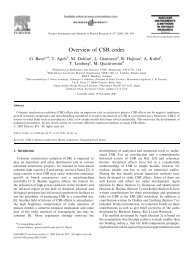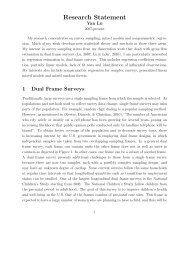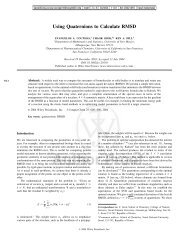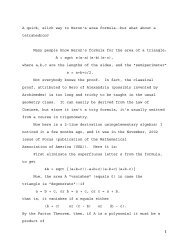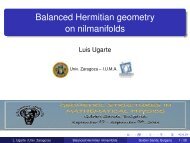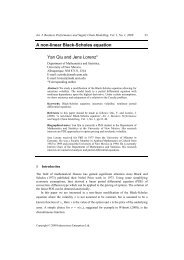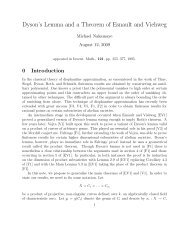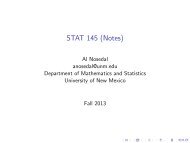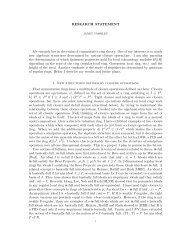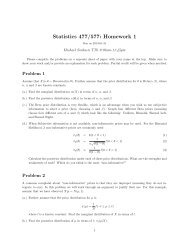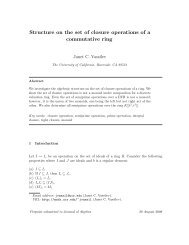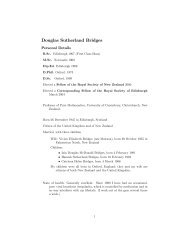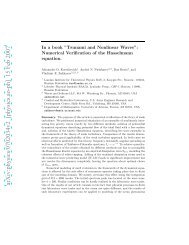OEO Office of Equal Opportunity - Department of Mathematics and ...
OEO Office of Equal Opportunity - Department of Mathematics and ...
OEO Office of Equal Opportunity - Department of Mathematics and ...
You also want an ePaper? Increase the reach of your titles
YUMPU automatically turns print PDFs into web optimized ePapers that Google loves.
160 ARTS AND SCIENCES<br />
565./465. Sociobiology <strong>and</strong> Evolutionary Ecology. (3)<br />
Charnov, Thornhill<br />
Evolutionary <strong>and</strong> social biology; speciation, adaptation, population<br />
ecology. {Fall}<br />
566./466. Immunogenetics. (3) Miller<br />
Classical <strong>and</strong> molecular genetics <strong>of</strong> immune responses,<br />
presented as a survey <strong>of</strong> the fundamental literature in immunology.<br />
Genetics <strong>of</strong> histocompatibility <strong>and</strong> the generation <strong>of</strong><br />
diversity in the immune system.<br />
Prerequisites: 556.<br />
567./467. Evolutionary Plant Ecology. (3) Marshall<br />
Evolutionary approach to the study <strong>of</strong> plants <strong>and</strong> plant<br />
populations. Will cover plant life history <strong>and</strong> strategies, plant<br />
population biology <strong>and</strong> plant reproduction with an emphasis<br />
on empirical studies. {Spring}<br />
571./471. Plant Physiological Ecology. (3) Pockman<br />
{Spring, alternate years}<br />
575./475. Plant Community Ecology. (3) Collins<br />
Plant community structure <strong>and</strong> dynamics in North American<br />
deserts <strong>and</strong> grassl<strong>and</strong>s. Field trip to Sevilleta LTER required.<br />
{Spring}<br />
576. L<strong>and</strong>scape Ecology <strong>and</strong> Macroscopic Dynamics.<br />
(4) Milne<br />
Conceptual <strong>and</strong> methodological approaches to l<strong>and</strong>scape<br />
ecology. Emphasis on climate, paleoecology <strong>and</strong> the quantitative<br />
representation, analysis <strong>and</strong> modeling <strong>of</strong> spatial<br />
complexity. {Spring, alternate years}<br />
581. Advanced Molecular Biology. (4)<br />
(Also <strong>of</strong>fered as BIOM 507.) The course covers the structures<br />
<strong>and</strong> functions <strong>of</strong> nucleic acids <strong>and</strong> proteins, mechanisms <strong>and</strong><br />
macromolecular synthesis <strong>and</strong> principles <strong>of</strong> enzymology.<br />
582. Advanced Cell Biology. (4)<br />
(Also <strong>of</strong>fered as BIOM 508.) Course covers advanced topics<br />
in cell biology, including microscopy, the nucleus, protein <strong>and</strong><br />
membrane trafficking, cytoskeleton signal transduction, cell<br />
cycle <strong>and</strong> division <strong>and</strong> extracellular matrix.<br />
Prerequisite: 581. {Spring}<br />
582L./482L. Parasitology. (4) Duszynski, H<strong>of</strong>kin, Loker<br />
The protozoa <strong>and</strong> worms important in human <strong>and</strong> veterinary<br />
medicine. Emphasis on life histories, epidemiology <strong>and</strong> ecology<br />
<strong>of</strong> parasites with laboratory practice in identification <strong>and</strong><br />
experimentation. Three lectures, 3 hrs. lab. {Spring}<br />
585L./485L. Entomology. (4) Molles<br />
Classification, phylogeny, natural history <strong>and</strong> literature <strong>of</strong><br />
insects. Three lectures, 3 hrs. lab. {Spring}<br />
591./491. Population Genetics. (3)<br />
(Also <strong>of</strong>fered as ANTH 591.) This course investigates how<br />
genetic variation is patterned within <strong>and</strong> between <strong>and</strong> how<br />
these patterns change over time. Topics include neutral theory,<br />
population structure, phylogenetics, coalescent theory,<br />
molecular clock, <strong>and</strong> laboratory methods.<br />
597./497. Principles <strong>of</strong> Gene Expression. (3) Cripps,<br />
Frankis<br />
A detailed <strong>and</strong> critical study <strong>of</strong> how different genes are regulated<br />
during the life <strong>of</strong> an organism, principally at the level<br />
<strong>of</strong> transcription.<br />
599. Master’s Thesis. (1-6)<br />
Offered on a CR/NC basis only.<br />
644. Mechanism <strong>of</strong> Gene Expression. (3)<br />
(Also <strong>of</strong>fered as BIOM 644.) Molecular mechanisms <strong>of</strong> gene<br />
expression. Topics include: mechanisms <strong>of</strong> protein-nucleic<br />
acid recognition, transcription, regulation, messenger RNA,<br />
<strong>and</strong> translation. {Spring, even years}<br />
651. Advanced Field Biology. (4-8)<br />
Approval <strong>of</strong> Committee on Studies required.<br />
699. Dissertation. (3-12)<br />
Offered on a CR/NC basis only.<br />
CHEMISTRY<br />
Cary Morrow, Chairperson<br />
<strong>Department</strong> <strong>of</strong> Chemistry<br />
MSC03 2060<br />
1 University <strong>of</strong> New Mexico<br />
Albuquerque, NM 87131-0001<br />
(505) 277-6655<br />
e-mail: chemgrad@unm.edu<br />
Pr<strong>of</strong>essors<br />
Stephen Cabaniss, Ph.D., University <strong>of</strong> North Carolina<br />
Lorraine Deck, Ph.D., The University <strong>of</strong> New Mexico<br />
Debra Dunaway-Mariano, Ph.D., Texas A&M University<br />
Hua Guo, Ph.D., Sussex University, United Kingdom<br />
Richard W. Holder, Ph.D., Yale University<br />
Richard Kemp, Ph.D., University <strong>of</strong> Texas<br />
Martin L. Kirk, Ph.D., University <strong>of</strong> North Carolina<br />
Patrick S. Mariano, Ph.D., University <strong>of</strong> Wisconsin<br />
Cary J. Morrow, Ph.D., Tulane University<br />
Mark R. Ondrias, Ph.D., Michigan State University<br />
Robert T. Paine, Jr., Ph.D., University <strong>of</strong> Michigan<br />
Associate Pr<strong>of</strong>essors<br />
James R. Brozik, Ph.D., Washington State University<br />
Deborah G. Evans, Ph.D., University <strong>of</strong> Pittsburgh<br />
David Keller, Ph.D., University <strong>of</strong> California (Berkeley)<br />
Assistant Pr<strong>of</strong>essors<br />
Paul Bentley, Ph.D., Liverpool University, United Kingdom<br />
David Tierney, Ph.D., University <strong>of</strong> Michigan<br />
Wei Wang, Ph.D., North Carolina State University<br />
Pr<strong>of</strong>essors Emeriti<br />
Fritz S. Allen, Ph.D., University <strong>of</strong> Illinois<br />
Roy D. Caton, Ph.D., Oregon State University<br />
Ulrich Hollstein, Ph.D., University <strong>of</strong> Amsterdam<br />
William M. Litchman, Ph.D., University <strong>of</strong> Utah<br />
Miriam Malm, M.S., The University <strong>of</strong> New Mexico<br />
Donald R. McLaughlin, Ph.D., University <strong>of</strong> Utah<br />
E. Paul Papadopoulos, Ph.D., University <strong>of</strong> Kansas<br />
Riley Schaeffer, Ph.D., University <strong>of</strong> Chicago<br />
Edward A. Walters, Ph.D., University <strong>of</strong> Minnesota<br />
UNM/S<strong>and</strong>ia National Laboratory Pr<strong>of</strong>essors<br />
C. Jeffrey Brinker, Ph.D., Rutgers University<br />
Also see Faculty Listings in Biochemistry.<br />
Introduction<br />
The program <strong>of</strong> the <strong>Department</strong> <strong>of</strong> Chemistry conforms to<br />
the st<strong>and</strong>ards prescribed by the American Chemical Society.<br />
The <strong>Department</strong> <strong>of</strong> Chemistry assigns prospective chemistry<br />
majors to faculty advisors <strong>and</strong> all undergraduate students<br />
planning to major in chemistry are encouraged to take advantage<br />
<strong>of</strong> this advisement program.<br />
NOTE: The policy <strong>of</strong> the <strong>Department</strong> <strong>of</strong> Chemistry<br />
regarding enrollment under the pass/fail (CR/NC)<br />
grade option is that CR (credit) will be given only for<br />
grades <strong>of</strong> C or better.<br />
The University has m<strong>and</strong>ated that all graduating seniors take<br />
part in an outcomes assessment program designed by their<br />
major departments. In Chemistry, this involves taking one or<br />
more <strong>of</strong> the American Chemical Society area assessment<br />
examinations <strong>and</strong> also discussing your educational experiences<br />
in the department in an individual exit interview. All<br />
graduating seniors are required to take part in this program.<br />
Major Study Requirements<br />
The Bachelor <strong>of</strong> Arts degree requires a minimum <strong>of</strong> 28 credit<br />
hours earned in chemistry courses beyond CHEM 121L<br />
or its approved equivalent. The B.A. must also include the<br />
UNM CATALOG 2006–2007 Symbols, page 611.



